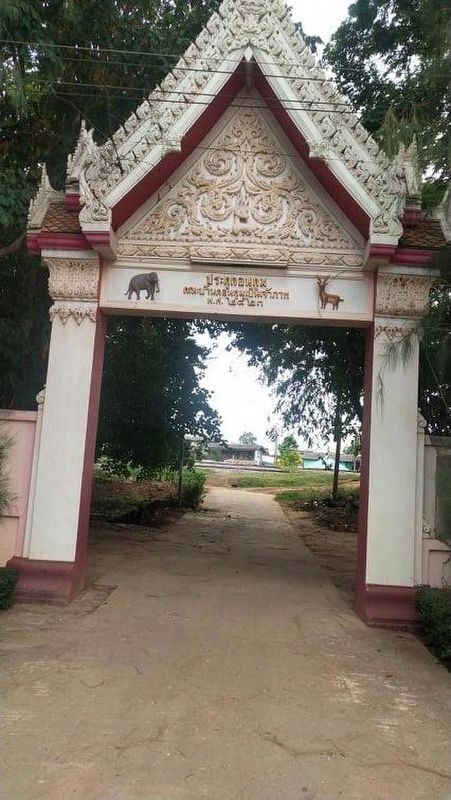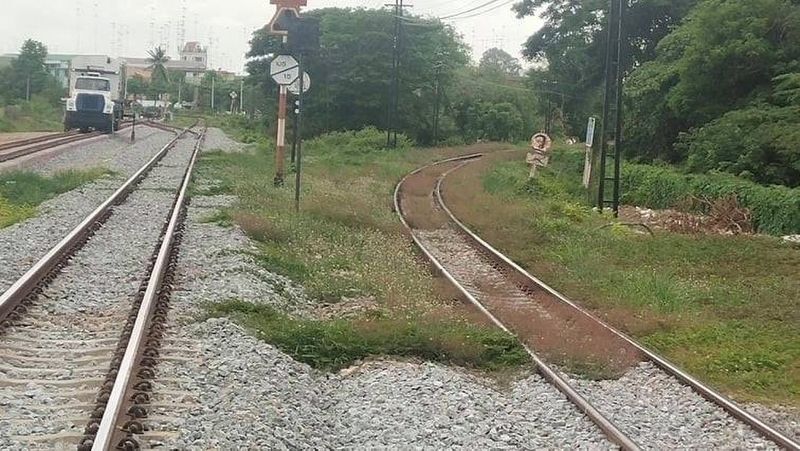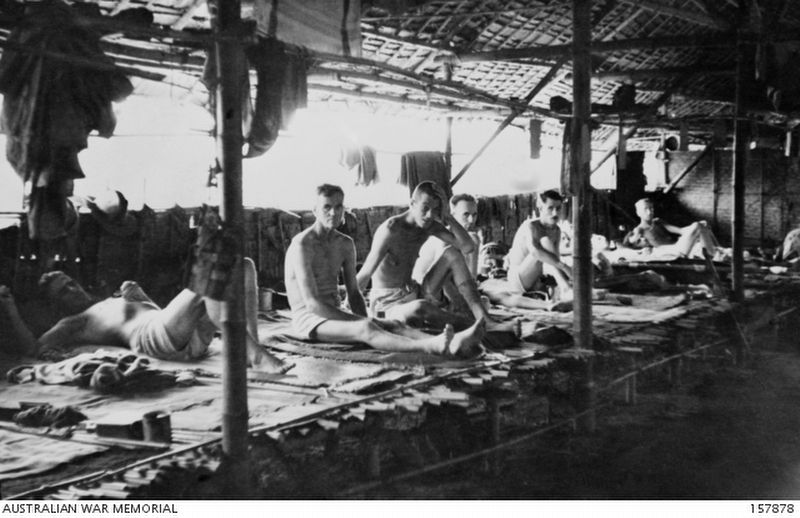Ban Pong in Ban Pong District, Ratchaburi, Thailand — ประเทศไทย (Southeast Asia, Indochinese Peninsula)
Don Toom Gate
Was Entrance to World War II Prisoners of War Camp
— The Thai-Burma Railroad Story Begins Here —
Inscription.
Don Toom Gate.
Erected by local contributors
in 2523 (1980)
Topics and series. This memorial is listed in this topic list: War, World II. In addition, it is included in the The Thailand-Burma Railway series list.
Location. 13° 48.903′ N, 99° 52.926′ E. Marker is in Ban Pong, Ratchaburi, in Ban Pong District. Memorial can be reached from 160 / 3233 Sam Ngan (Local Route 3233). It is at the far end of the temple compound from the main gates. Past the gate are the railroad tracks. Touch for map. Marker is in this post office area: Ban Pong, Ratchaburi 70110, Thailand. Touch for directions.
Other nearby markers. At least 2 other markers are within 3 kilometers of this marker, measured as the crow flies. Imperial Japanese Army Soldiers Memorial Chedi (about 120 meters away, measured in a direct line); Thai-Burma Railway Starting Station (approx. 3 kilometers away).
More about this marker. The gate itself is a World War II war memorial. The present structure replaced the gate that was here during the war.
This is and was an active Buddhist temple, the Wat Daun Dtum. The temple is located in the curve of the railroad were it begins its westward trek to Kanchanaburi—and at one time all the way to Burma—as it swings thru BanPong from nearby NongPlaDuk. In World War II the central open field of the temple compound held the Imperial Japanese Army’s BanPong POW transit camp. There is no trace of any of the temporary structures today.
Regarding Don Toom Gate. Between 1942 and 1943 tens of thousands of Allied POWs and Asian Forced Laborers arrived at this camp from Singapore or Malaya before being put to work on the Thai-Burma Railway. They disembarked from railroad cars and and walked through the gate into the camp, and into the horrors of forced labor, starvation, punishment, and disease. Many of them considered it the “Gate to Hell.”
Also see . . .
1. U.S. POW Thai-Burma Railway Story - Wat Don Toom. Excerpt:
As we spoke to the 2 monks we were practically standing on the open field that the article describes as the site of a POW compound. However, neither monk knew anything specific about a POW camp except that indeed there was one in the general area. The article clearly states that this central field was the actual site of at least part of the BanPong POW transit camp.(Submitted on July 11, 2023.)
2. Wikipedia entry for the Burma Railway. The article begins:
The Burma Railway, also known as the Siam–Burma Railway, Thai–Burma Railway and similar names, or as the Death Railway,(Submitted on July 11, 2023.)is a 415 km railway between Ban Pong, Thailand, and Thanbyuzayat, Burma (now called Myanmar). It was built from 1940 to 1943 by civilian laborers impressed or recruited by the Japanese, and prisoners of war taken by the Japanese, to supply troops and weapons in the Burma campaign of World War II.
It completed the rail link between Bangkok, Thailand, and Rangoon, Burma. The name used by the Japanese Government was Tai–Men Rensetsu Tetsudō (泰緬連接鉄道), which means Thailand-Burma-Link-Railway.
Between 180,000 and 250,000 Southeast Asian civilians and over 60,000 Allied prisoners of war were subjected to forced labour during its construction. Around 90,000 civilians died, as did more than 12,000 Allied prisoners.
Most of the railway was dismantled shortly after the war. Only the first 130 kilometres (81 mi) of the line in Thailand remained, with trains still running as far north as Nam Tok.
Additional keywords. transit camp, Bridge on the River Kwai, Death Railway
Credits. This page was last revised on July 14, 2023. It was originally submitted on June 10, 2023, by Jj Karwacki of Tha Maka, Kanchanaburi. This page has been viewed 54 times since then and 6 times this year. Photos: 1, 2. submitted on June 10, 2023, by Jj Karwacki of Tha Maka, Kanchanaburi. 3. submitted on July 11, 2023, by J. J. Prats of Powell, Ohio. • J. J. Prats was the editor who published this page.


